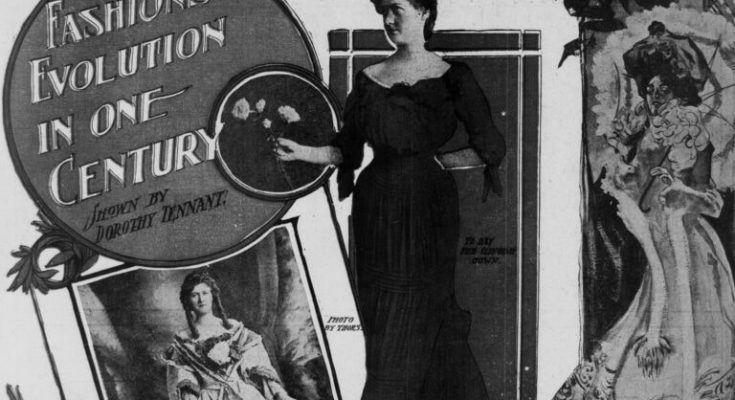The San Francisco Call (San Francisco, CA), August 17, 1902. Image credit: LoC1900 to 1910
#LibraryOfCongress; #WomenFashionHistory
Washington/Canadian-Media: Women’s fashion’s long and colorful history in the 20th century was fully captured by the newspapers with full newspaper pages with photographs of the latest fashions from Paris, department store advertisements with drawings of the popular frocks of the day, and articles covering social events and what fashionable people in attendance were wearing, Library of Congress (LoC) reported.
In this part 1 of a 3-part series that will span fashion history from 1900 to 1960, starting with the time period 1900 to 1920.
With significant technological advancements seen in the first decade of the 20th century, women’s fashion remained largely similar to the looks of the preceding century. The structured silhouette of the Gibson Girl was popular during the beginning of the decade, and had the idealized look of Edwardian era style, with lace and other embellishments as essential. women’s fashion in those days was dominated by modest dresses, bodies molded by corsets, and garish ornamentation.

“The Girl of 1900,” Daily Inter Mountain (Butte, MT), January 6, 1900. Image credit: LoC

The fashionable silhouette, for a large part of the decade, was the S-shape created by a new “health corset,” which removed pressure from the abdomen, but resulted in the bust being pushed forward and the hips pushed back. Tops were loose and blousy helping to emphasize a top-heavy shape. Sleeves were also dramatic and long, heavy skirts were enhanced with frilly petticoats.
Modesty was emphasized by day dresses covering the body from neck to the floor with long sleeves covering the arms, and bell-shaped skirts adorned with lace made typically out of rich fabrics such as silk satin, damask, and chiffon, usually in light, soft colors. The fashionable look overall was that of a mature and sophisticated woman.
Evening dress with the same silhouette and these gowns were more revealing with low necklines and short sleeves, often offset by wearing long gloves. Sleeves were also sometimes draped off the shoulder.
An evening gown, 1909. The Daily Missoulian (Missoula, MT), March 21, 1909. Image credit: LoCDuring the latter end of this period, many women started to work outside the home for the first time and had “tailor-made” woman’s skirt suit which were more functional and stylish became a symbol of independence.
Though the prevailing style favored embellished day and evening dresses, women began to focus on dressing for the occasion. There was an increased importance placed on event-specific dressing. Wealthy women tended to have many costumes, ranging from theatre and evening gowns to morning and afternoon dresses and practical costumes for outdoor and sporting pursuits.
Also during this period, sports such as golf, tennis, cycling and motoring began to have influence on fashion and inspired new styles.
Here is a side-by-side view of women’s fashion over the course of the decade, 1900 to 1910:
Fashion began to soften as the decade progressed. The rigid S-shape popular in the early part of the decade gradually straightened out into a more natural shape. Billowy blouses hanging over the waist in front were replaced with narrower loose tops, sleeves, and skirts. Waists were higher and a tubular silhouette began to emerge as fashion moved into the 1910s.
Click on the timeline below to see how fashion changed year to year, from 1900 to 1910:
1900 — 1901 — 1902 — 1903 — 1904 — 1905 — 1906 — 1907 — 1908 – 1909 — 1910
Here is a side-by-side view of women’s fashion over the course of the decade, 1900 to 1910:

1902. The San Francisco Call (San Francisco, CA), August 10, 1902.
1904. The Birmingham Age-Herald (Birmingham, AL), August 6, 1904.
1906. The San Francisco Call (San Francisco, CA), April 8, 1906.
1908. Los Angeles Herald (Los Angeles, CA), November 22, 1908.
1910. Los Angeles Herald (Los Angeles, CA), October 23, 1910.1911-1920
Fashion of the 1910s can be split into two periods: before the war and during the war. The First World War had a fundamental effect on society and culture, and fashion was no exception.

1910. Omaha Daily Bee (Omaha, NE), January 2, 1910.
1912. The Washington Herald (Washington, DC), February 18, 1912.
1914. The Times-Dispatch (Richmond, VA), October 25, 1914.
1916. The Sunday Telegram (Clarksburg, WV), January 2, 1916.
1918. The Ogden Standard (Ogden City, UT), May 11, 1918.
1920. Richmond Times-Dispatch (Richmond, VA), September 19, 1920





